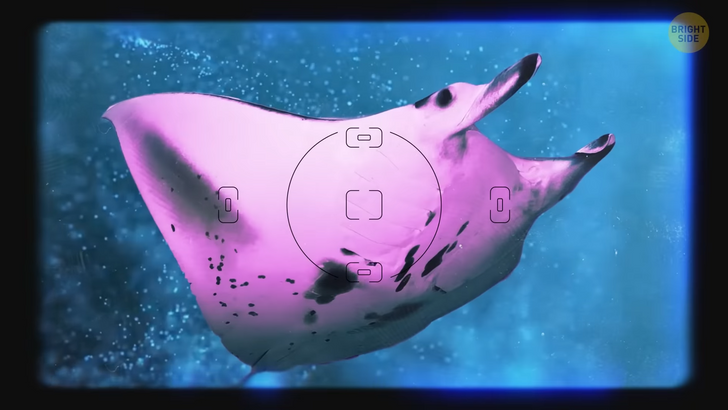It was a regular dive in Australia’s Great Barrier Reef for underwater photographer Kristian Laine. He was taking photos of a group of male manta rays chasing a female one when suddenly he saw something that made him check if his camera strobes had been broken. There was a pink manta ray in his viewfinder!

Other underwater beauties of its kind are usually black on top and white underneath. The creature Kristian met that day was black on top and pink on the bottom. It turned out the photographer met Inspector Clouseau, the only known pink manta ray in the world living in the waters around Lady Elliot Island. It was named after the famous detective from Pink Panther movies. It was calm, looking at the photographer with its huge eyes. It even seemed that it was smiling at his guest, as Kristian remembered in an interview.
He managed to take 5 good photos of Inspector Clouseau in the 30 minutes they spent together. Divers first spotted the unique manta ray in 2015, and it was only seen less than ten times ever since. First, the scientists thought the secret to this unusual color was in its diet. They took a sample of its skin and found out it was actually a result of a genetic mutation that caused it to express melanin differently. Many fish have it, but it usually turns them into albinos.
For a regular sea creature, a combo of black, which blends with dark waters and can’t be seen from above, and white, which blends with light, is ideal protection. A color mutation with pink in the picture would make other sea animals more vulnerable to predators. But a manta ray weighing as much as a car and 1.5 times taller than an average basketball player definitely has nothing to be afraid of. These creatures are born rather big and grow fast in the first few years, so they can defend themselves.

If you were impressed by a manta ray the shade of bubble gum, meet blue bees! These unique Australian inhabitants have turquoise stripes instead of yellow, which makes them look like flying sapphires. Their thin brown wings look like layers of cellophane with engraved patterns. Another unusual thing about them is their lifestyle: the blue-banded bees are singles. They don’t move in swarms and don’t live in large nests.
They prefer settling in small burrows in the soil or crevices in rocks. Blue bees also have a special way of pollination. They sit on the flower, hold it tightly, and shake the whole body to make the flower move quickly and gently. Then, the bees stop and collect all the pollen that goes out of the capsule inside the flower. Blue bees work for Australian agriculture, helping with tomatoes, cranberries, eggplants, blueberries, kiwi, and chili peppers.
The next unique Australian animal is called the happiest on this planet. A quokka never stops smiling and looks like a live teddy bear. It’s a nocturnal creature the size of a cat. It has inherited its appearance from its relative — the kangaroo. It also has a pouch, which serves as a home for its offspring for 6 months.
Quokkas have a diet of grass, shrubs, and leaves. When there isn’t enough food, they can use stored fat in their tails as a source of energy. They mostly live on Rottnest Island off the coast of Western Australia. Since there are no predators or traffic there, quokkas have nothing to fear and gladly come into contact with humans. It’s against the law to touch them, but no one has banned taking selfies.

Leave a Reply